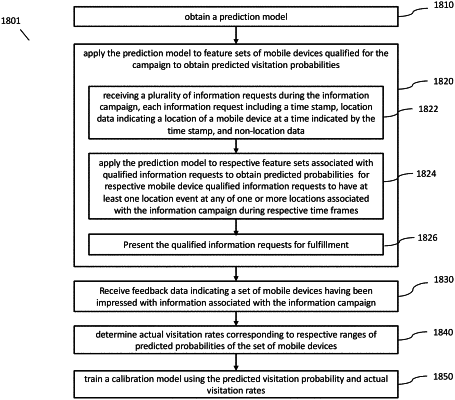| CPC H04W 4/021 (2013.01) [G06F 16/29 (2019.01); G06N 20/00 (2019.01); H04L 67/52 (2022.05)] | 18 Claims |

|
1. A method, comprising,
at one or more computer systems coupled to a packet-based network and including, or having access to, one or more databases storing therein datasets associated with mobile devices, a respective dataset including data related to an associated mobile device, a respective time stamp, and at least one respective event involving the associated mobile device at a time indicated by the respective time stamp:
for each respective request of a first plurality of requests received from the packet-based network during a first time unit:
determining whether the respective request qualifies for information delivery based on respective request data included in the respective request and a set of information delivery parameters;
in response to the respective request qualifying for information delivery, predicting a respective conversion probability for the respective request, the respective conversion probability corresponding to a predicted probability of a mobile device associated with the respective request having at least one location event at any of one or more POIs during a first time frame corresponding to the first time unit;
inputting the respective conversion probability to a bidding model to determine a respective bid for fulfilling the respective request; and
transmitting the respective bid to the packet-based network;
receiving feedbacks from the package-based network, the feedbacks indicating a first set of requests having been fulfilled among the first plurality of requests;
determining a projected number of conversions using predicted probabilities of the first set of requests;
determining a predicted number of conversions using a win rate profile and predicted conversion probabilities of qualified requests, the win rate profile for estimating a rate for wining a bid on a request having a predicted conversion probability in any of a plurality of ranges of predicted conversion probabilities; and
adjusting the bidding model based at least on the predicted number of conversions and the projected number of conversions;
wherein predicting a respective conversion probability for the respective request includes constructing a respective feature set for the respective request using at least the respective request data, and applying a machine-trained location prediction model to the respective feature set to obtain the respective conversion probability; and
wherein the method further comprises machine-training the location prediction model using at least a training feature space and a set of training labels, the training feature space being constructed using datasets having time stamps in a training time period, the set of training labels being determined using datasets having time stamps in a training time frame.
|